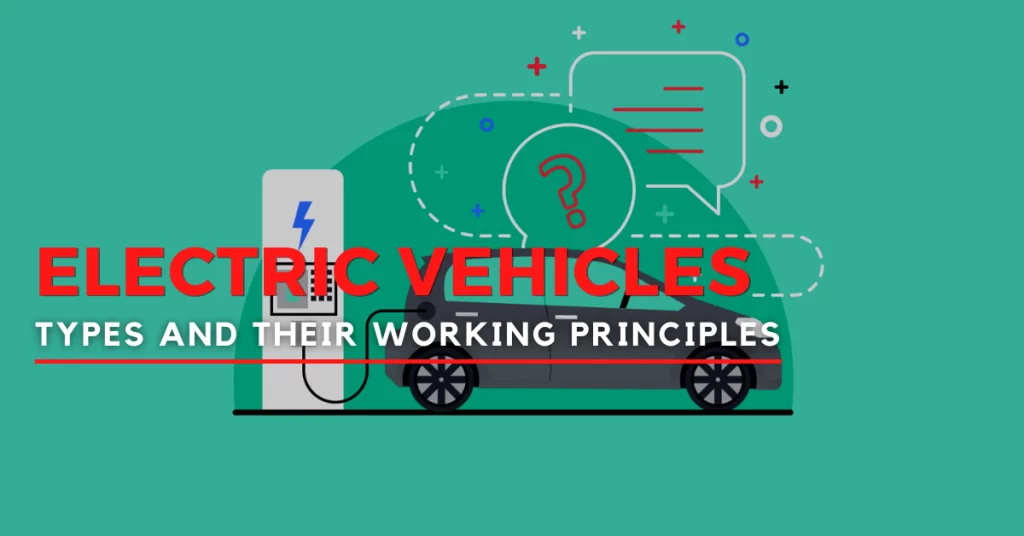Electric cars are constantly changing and improving, giving people who use them and people who might use them more options. Today, more and more people know what BEV, HEV, PHEV, and FCEV mean. How does a car run on electricity? How an electric car works depends on what kind it is. This article will briefly discuss the different types of electric vehicles and how they work in the World.
An electric car is a vehicle that is powered in whole or in part by electric motors that get their energy from rechargeable batteries. In the 1880s, people made the first electric cars. People liked to drive electric cars in the late 1800s and early 1900s. Electric vehicles aren’t as popular as they used to be because of new and better internal combustion engines (ICE) and the mass production of cheaper gasoline cars.
The rise of interest in electric vehicles can be attributed to the progress that has been made in the field of energy storage technology, particularly battery technology. So how exactly does an electric automobile function?
What are the internal workings of an electric car?
When the pedal of the car is pressed, then the following will occur:
- The controller draws the electrical power from the batteries and inverters and then regulates it.
- After the controller has been programmed, the inverter will then deliver the motor a predetermined quantity of the available electrical power (according to the depth of pressure on the pedal)
- Electric motor transforms electrical energy into mechanical energy (rotation)
- Motor rotation was seen. The rotor turns the transmission, which in turn causes the wheels to revolve, ultimately resulting in the vehicle moving.
This applies to BEVs or battery electric vehicles.
4 Different kinds of electric Cars
There are four distinct categories of electric cars, which can be summarised as follows:
- Vehicle-powered entirely by batteries (BEV)
- Hybrid Electric Vehicle with a Gasoline Engine (HEV)
- Plugged In Hybrid Electric Vehicle (PHEV)
- Fuel Cell Electric Vehicle (FCEV)
Battery Electric Vehicle (BEV)
Battery Electric Vehicles (BEVs), also known as All-Electric Vehicles (AEVs), are automobiles propelled only by an electric drive train and powered by batteries. These electric cars do not have an internal combustion engine (ICE). Large batteries are used to store electricity, and these batteries are recharged by connecting them to the public power supply. In turn, the battery pack supplies electricity to one or more electric motors, allowing the electric car to go forward.
BEV Working Principles
- The DC battery is converted to AC for the electric motor.
- The accelerator pedal transmits a signal to the controller, which modifies the frequency of the AC power from the inverter to the motor to modify the vehicle’s speed.
- Through a gear, the motor connects to and turns the wheels.
- When the brakes are applied or the electric vehicle decelerates, the motor transforms into an alternator and sends power back to the battery.
Volkswagen e-Golf, Tesla Model 3, BMW i3, Chevrolet Bolt, Chevrolet Spark, Nissan LEAF, Ford Focus Electric, Hyundai Ioniq, Karma Revera, Kia Soul, Mitsubishi i-MiEV, Tesla X, and Toyota Rav4 are examples of BEVs.
Hybrid Electric Vehicle (HEV)
The term “standard hybrid” or “parallel hybrid” is frequently used to refer to vehicles that use hybrid technology. An HEV combines an internal combustion engine (ICE) with an electric motor. Internal combustion engines, including those in such types of electric cars, derive energy from gasoline and other fuels, while motors obtain electricity from batteries. The transmission, responsible for driving the wheels, is rotated simultaneously by the gasoline engine and the electric motor.
HEV working principles
- Like a standard automobile, it has a fuel tank that delivers gasoline to the engine.
- Additionally, it is equipped with a set of batteries that can power an electric motor.
- The internal combustion engine and the electric motor can turn the transmission simultaneously.
Toyota Prius Hybrid, Honda Civic Hybrid, Toyota Camry Hybrid, and Honda Civic Hybrid are all examples of hybrid vehicles.
Plug-in Hybrid Electric Vehicle (PHEV)
A plug-in hybrid electric vehicle (PHEV) is a type of hybrid vehicle that combines the advantages of an internal combustion engine (ICE) and an electric motor. This electric vehicle category allows drivers to select their power source.
This category of electric vehicles is driven by a combination of a traditional fuel source (like gasoline) or an alternative fuel source (like bio-diesel) and a battery pack that can be recharged. By connecting the battery to a source of electrical current, such as a wall outlet or a charging station for electric vehicles, the battery can be recharged (EVCS).
PHEVs are often capable of operating in at least two distinct modes:
- Modes include the all-electric Mode, where the motor and battery supply the vehicle’s energy.
- In Hybrid Mode, gasoline and electricity are used; in Eco Mode, the car uses just electricity.
PHEV working principles
- Most PHEVs start up in all-electric Mode and stay in that Mode until the battery pack runs out.
- When some models reach highway cruising speed, which is usually above 60 or 70 miles per hour, they switch to hybrid mode. Once the battery is dead, the engine takes over, and the car works like a regular hybrid that is not plugged in.
- PHEV batteries can be charged by an internal combustion engine or by regenerative braking. They can also be charged by plugging them into an outside electric power source.
- When the electric motor is used to slow down, it acts as a generator, using the power to charge the battery.
- The electric motor adds to the power of the engine. This means that smaller engines can be used, which saves fuel without hurting performance.
The Porsche Cayenne S E-Hybrid, the Chevy Volt, the Chrysler Pacifica, the Ford C-Max Energi, the Ford Fusion Energi, the Mercedes C350e, the Mercedes S550e, the Mercedes GLE550e, the Mini Cooper SE Countryman, the Audi A3 E-Tron, the BMW 330e, are all PHEV Examples.
Fuel Cell Electric Vehicle (FCEV)
Fuel Cell Electric Vehicles (FCEVs), also known as fuel cell vehicles (FCVs) or Zero Emission Vehicles, are different kinds of electric cars that use a technology known as “fuel cell technology” to generate the necessary amount of electricity to power the vehicle. Other names for FCEVs include Zero Emission Vehicles. In this category of automobiles, the potential chemical energy of the fuel is directly transferred into the possible electrical power of the vehicle.
FCEV working principles
- A “fuel cell” electric cars operates on a fundamentally distinct concept from a “plug-in” electric vehicle in terms of how power is generated.
- Because the FCEV creates the power required to run this vehicle on the vehicle itself, this electric automobile is known as a “fuel cell electric vehicle.”
Hyundai Nexo, Honda Clarity Fuel Cell, Riversimple Rasa, Toyota Mirai, and Hyundai Tucson FCEV are some examples of hydrogen fuel cell vehicles.
Simplify the Car Purchasing Experience with Car Concierge Pro
The Car Concierge Pro offers to simplify the Car Purchasing Experience By Dealership. Our goal is to make the car-buying process as simple as possible for our consumers. You can shop like a pro and save thousands of dollars using the Car Concierge Pro, pay cash for your vehicle, and don’t fall for the dealership’s frills.




 and Canada
and Canada 





